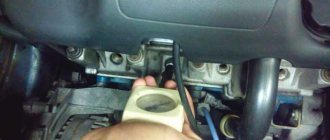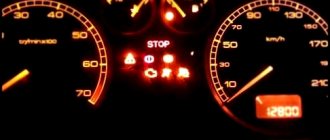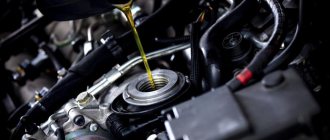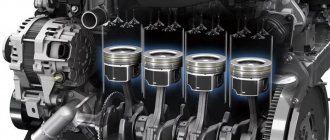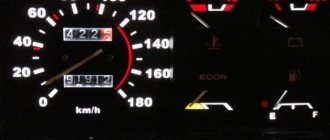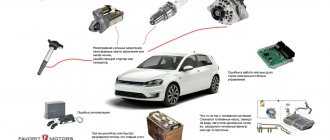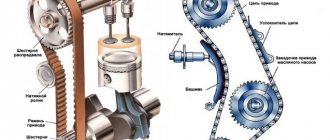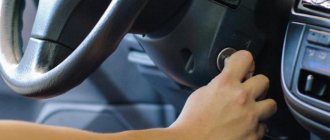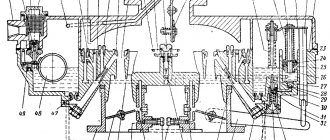Causes and malfunctions and how to fix them
Lack of fuel in the carburetor
- There may be problems with the fuel supply to the carburetor. We check the fuel supply system (before entering the carburetor) by removing the hose from the fuel supply fitting on the carburetor and pressing the pump lever on the fuel pump several times. A strong, pulsating stream of fuel should come out of the hose opening. If the stream is weak or not at all, then the fuel pump or some other element of the power system may be faulty. As a result, the fuel supply is insufficient or stops altogether.
The strainer at the carburetor inlet is clogged
- We take out the mesh filter by unscrewing its plug, rinse it, clean it with a brush (you can use a toothbrush), blow it out and put it back. At the same time, we clean the seat under the filter in the carburetor cover.
The EPH valve or system has failed
- With the engine off, turn on the ignition and try removing and installing the wire end from the valve outlet. A click should be heard. If it is not there, we connect a piece of wire plus the battery and the valve outlet. There is no click - we change the valve. A click appears - we are checking the EPH system. In addition, it is worth checking the presence and integrity of the rubber O-ring on the valve.
- On carburetors with an idle fuel jet holder, unscrew the holder and remove the jet from it. Clean, rinse and blow with compressed air. We put it back.
“Suction” of foreign air into the carburetor
- Inspect the tubes and hoses leading to the carburetor. Perhaps they have come off the fittings or are damaged. As an example, carburetor 2108-1107010 and hoses leading to it.
The fuel or air jets of the main carburetor metering system are clogged
- In this case, the fuel mixture will be lean. On 2105-07 carburetors, it is necessary to remove the carburetor cover, unscrew the fuel nozzle of the first chamber, and clean it with a thin wooden stick or copper wire. Then blow it out with compressed air and screw it back in. At the same time, it is worth cleaning the remaining elements of the main carburetor metering systems (shown in the photo). On carburetors 2108-21083, we also remove the cover and unscrew the air jet of the first chamber. We take out the jet along with the emulsion tube. Using a slotted screwdriver, unscrew the fuel nozzle located at the bottom of the emulsion well. We wash, clean, blow through it and at the same time the emulsion tube and the emulsion well.
Carburetor needle valve not sealing
- The carburetor overflows, the spark plugs are wet after starting. Replace the worn unit, as even the slightest fuel leak can lead to serious problems. Visually, there may be streaks of gasoline on the carburetor and a persistent smell. Remove the carburetor cover and check whether the float bracket is stuck on its axis, whether the float is touching the walls of the float chamber, or whether the needle valve body is loose. You can try to start the engine if, when starting, you turn it for a long time with the starter while pressing the gas pedal all the way. In this case, due to increased ventilation of the combustion chambers, the spark plugs will dry out and the fuel mixture will normalize. To begin with, you can check the tightness of the needle valve of the float chamber.
The fuel level adjustment in the carburetor float chamber is broken
In this case, the mixture again becomes overrich due to an increase in the fuel level in the float chamber. Adjust it.
Before searching for the reasons that a hot carburetor engine does not start, it is recommended to check the serviceability of the ignition system, since the symptoms of its malfunction are similar to the symptoms of a malfunction of the ignition system.
If you find an error, please select a piece of text and press Ctrl+Enter.
Why do you have to adjust the idle speed?
For proper adjustment, you need to know how to adjust idle operation. If everything is done correctly, the procedure will not take much time. However, to do this you need to understand how the carburetor works and how it works. The main trouble associated with this problem is not the lack of idle speed, but the fact that the engine cannot operate stably and stalls.
Why can't the engine hold idle?
If the engine does not hold idle, first, you need to check the solenoid valve. However, it is not installed on all types of carburetors used in the VAZ 2106. If it is, then most often the problem is hidden in it.
In its operation, the valve is similar to a starter solenoid relay, it is even designed in the same way: there is a winding, a spring, a stator, but the overall dimensions are much smaller. The solenoid valve is needed to open fuel access when the throttle valve is in the closed position (gas pedal released). When the ignition is turned off, the valve should block fuel from reaching the carburetor.
- Why does the VAZ 2109 carburetor overflow?
Malfunctions of the solenoid valve that cause problems with stable idle speed include the following breakdowns:
- the winding is broken, the rotor does not move, and fuel does not enter the float chamber;
- the fuel nozzle is clogged with dirt;
- the rotor is deformed and jammed.
There is no need to contact specialists to diagnose valve problems. To check, just take a piece of wire and strip it from both sides of the insulation. One end of the wire must be connected to the positive terminal of the battery, the second is connected to the contact of the solenoid valve. There should be a click when connected. If this does not happen, the valve is faulty and should be replaced. There was a click - then you need to remove the wire and turn on the ignition, and then connect the terminal block to the valve terminal. If a click is not heard, this indicates a wire break in one of the sections of the circuit.
Why the VAZ-2106 does not start and what to do
Cars from the Togliatti Automobile Plant are simply extremely popular among domestic consumers.
However, the main reasons for the demand for them can only be said to be the relatively low price and availability of spare parts. Otherwise, these vehicles are much inferior to imported cars. Quite often, owners of domestic cars are faced with the fact that the VAZ-2106 does not start. What is the reason for this problem, and what to do if it has happened to you? In this article we will provide answers to these questions, and also give a number of useful tips for repairing the “six”.
The starter rotates, but there are no flashes
The next typical malfunction is the rotation of the starter in the complete absence of flashes. Here are the reasons why this could happen:
- broken timing belt. The first thing the owner of a VAZ 2106 should do when noticing the rotation of the starter without flashes is to check the integrity of the timing belt. It's simple: the starter rotates properly, but the torque is not transmitted to the crankshaft, since there is simply nothing to transmit it to, since the timing belt has broken (or has flown off the guides - this also happens if the belt is heavily worn and begins to sag). The solution is obvious: the timing belt will have to be changed;
Checking the performance of the power system
If your car won't start, we suggest starting with diagnosing the power system. It is quite possible to do it yourself. This requires:
- open the air filter;
- pour about 10 milligrams of gasoline directly into the carburetor;
- turn the ignition key. If the car starts and immediately stalls, it means that there is a serious problem in the fuel supply to the power unit;
- remove the clamp that tightens the hose connected to the carburetor;
- lower the other end of the hose into a container. Best of all - in a transparent bottle;
- press the fuel pump lever to see if fuel is supplied to the carburetor. If the result is negative, we repair the power system.
Most often, in this very system, the fuel pump fails, which is very sensitive to low-quality fuel. Special filters provide its protection, but over time, the filter elements become clogged and substances enter the pump that negatively affect its operation.
If this is the case, you will need to dismantle the device, thoroughly clean it, install new filters, and only then carry out installation.
Another problem with the fuel pump is air getting into it. To eliminate this problem, you need to very carefully check the entire line, and then eliminate any leaks found.
Poor starting of the VAZ 2107 engine in the cold season
Almost all the problems with the VAZ 2106 engine listed above are typical for the warm season. Poor starting of the “six” engine in winter should be discussed separately. The main reason for this phenomenon is obvious: frost. Due to the low temperature, the engine oil thickens, as a result, the starter simply cannot crank the crankshaft at a high enough speed. In addition, the oil in the gearbox also thickens. Yes, when the engine starts, the car is usually in neutral gear. But on it, the shafts in the gearbox are also rotated by the engine. And if the oil thickens, these shafts create a load on the starter. To prevent this from happening, you need to fully depress the clutch when the engine starts. Even if the car is in neutral gear. This will take the load off the starter and speed up the start of a cold engine. There are a number of other typical problems due to which the engine cannot start in cold weather. Let's list them:
- poor compression in the engine. This problem is very often observed in old “sixes” with high mileage: compression in the cylinders in the cold becomes very low. Not only can compression be low, but it can also be different. For example, in two cylinders it is normal, in the other two it is low. If the driver has found out that the reason for poor engine starting is low compression, and the car needs to be started urgently, then you should unscrew all the spark plugs and add a little engine oil to the combustion chambers (it is better to do this using a syringe - five “cubes” of oil in each cylinder will be sufficient). After this, you should crank the starter of the car several times without screwing in the spark plugs. The spark plugs are then screwed into place and the engine starts as the engine oil significantly increases compression in the cylinders (albeit only briefly). And to completely eliminate the problem, a major overhaul of the engine should be carried out. And in particular - replacing the piston rings. Without this, normal compression in the cylinders cannot be restored. There is another way to start a hopelessly frozen car: use the so-called starting fluid. It is sold in auto parts stores. It is injected directly into the carburetor (to do this, you will have to unscrew the air filter cover). And if you don’t want to tinker with the filter cover in the cold, you can unscrew the spark plugs and inject liquid into the combustion chambers. This is also an option, although not as effective;
Problems with the fuel line and carburetor
At the next stage, you need to check the fuel line very carefully - it is quite possible that it is damaged, which is why fuel simply does not flow into the engine.
If no damage has been identified, move on to the carburetor. This device ensures the ignition of gasoline and is also responsible for its enrichment. Dismantling a carburetor is a rather complicated procedure, which is best left to experienced professionals. But if you have repaired your car several times, you can do everything yourself. After disassembly, troubleshooting of device parts is carried out, replacement of worn or failed components, as well as installation and adjustment of the carburetor.
Problems with the carburetor also explain the difficulties with starting the engine when hot. The thing is that the needle of this device can move from the required level. This will lead to over-enrichment of the fuel. Symptoms of this breakdown are a constantly disappearing spark, as well as operation of the power unit at low speeds immediately after start-up.
Other reasons why the VAZ-2106 does not start
Quite often, the car does not want to start immediately after major or routine repairs. Basically, this problem is caused by poor ignition timing adjustment. You can eliminate it in the following way:
- set the piston of the first cylinder to the highest point of the end of the compression stroke;
- unscrew the candle, close the hole for its installation with a plug made of fabric;
- crank the car's crankshaft;
- After the plug is pushed out of the hole, we fix this position.
In addition, after repairing the car, it is necessary to correctly set the valve timing, for which all indicators are set according to the marks applied at the factory.
VAZ 2106 does not start well when hot
Unread message by Andreys » Tue Jan 26, 2010 6:48:05 AM
Unread message Buiny » Tue Jan 26, 2010 6:49:02 AM
Unread message vit84 » Tue Jan 26, 2010 7:31:56 AM
Yes, it’s normal, I was already thinking maybe, I’m stupid about the carb, I specially went to the city to see a carburetor (trusted) and watched how he does everything exactly the same as me and it doesn’t matter. such a pest.
Added after 1 minute 38 seconds:
no, when you press the throttle it “flows”
Added after 1 minute 18 seconds:
Yes, I tried that too, sometimes it helps, but mostly you drive even longer
Added after 9 minutes 22 seconds:
And I missed one more thing: when you start it hot, it grabs from the first turn (but weakly) and then it starts Zhi-Zhi-Zhi
Added after 29 minutes 54 seconds:
Difficult to start when hot
Unread message mort » Mon May 17, 2010 23:38:21
Re: Hard to start when hot
Unread message Curious » Mon May 17, 2010 23:48:01
Re: Hard to start when hot
Unread message Violent » Tue May 18, 2010 5:51:13 AM
Re: Hard to start when hot
Unread message by Longenen » Tue May 18, 2010 10:51:56 AM
Re: Hard to start when hot
Unread message by Jakson » Tue May 18, 2010 11:27:09
Re: Hard to start when hot
Unread message mort » Tue May 18, 2010 12:10:29 PM
Re: Hard to start when hot
Unread message by Longenen » Tue May 18, 2010 12:16:49
Re: Hard to start when hot
Unread message by Longenen » Tue May 18, 2010 12:19:23
Re: hard to start when hot
Unread message Vazik 07 UA » Wed Jun 09, 2010 10:00:06
Re: hard to start when hot
Unread message byran » Wed Jul 21, 2010 9:22:00 AM
Somehow I didn’t attach any importance, but I’m thinking, let me figure out why when I start it in the morning when it’s not cold (without an air damper), it starts like a tick. But when the car is warmed up, starting is a little difficult, you have to turn the starter for 2-3 seconds. Let's decide something.
Here's what I found: A hot engine does not start or takes a very long time to start.
As a rule, this occurs due to a leak in the fuel valve, but, generally speaking, even with a working carburetor in hot weather, hot starting is difficult (especially in the time range of 15-30 minutes after stopping) due to the fact that the air temperature in the engine compartment rises to 100-110°C (heat stroke). The pressure in the hoses rises, the carburetor float mechanism bleeds fuel into the float chamber and, accordingly, into the engine, causing it to become very rich. source: autocry Who thinks what?
